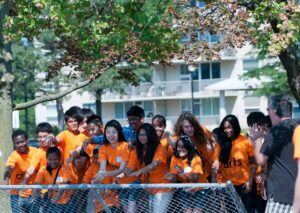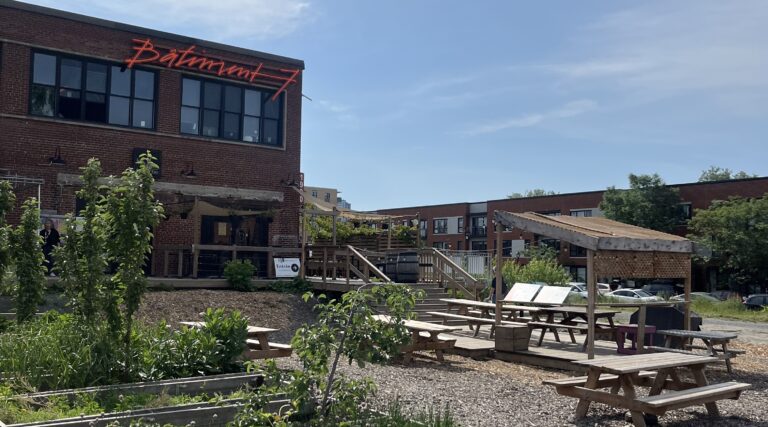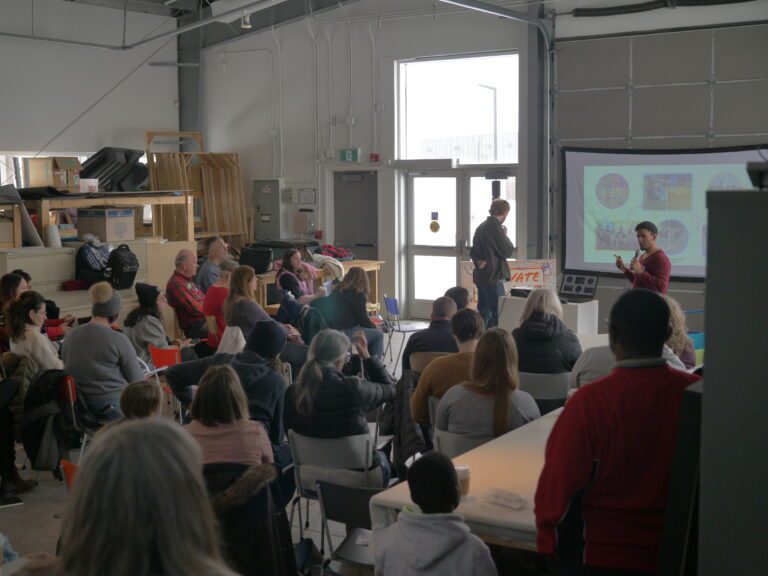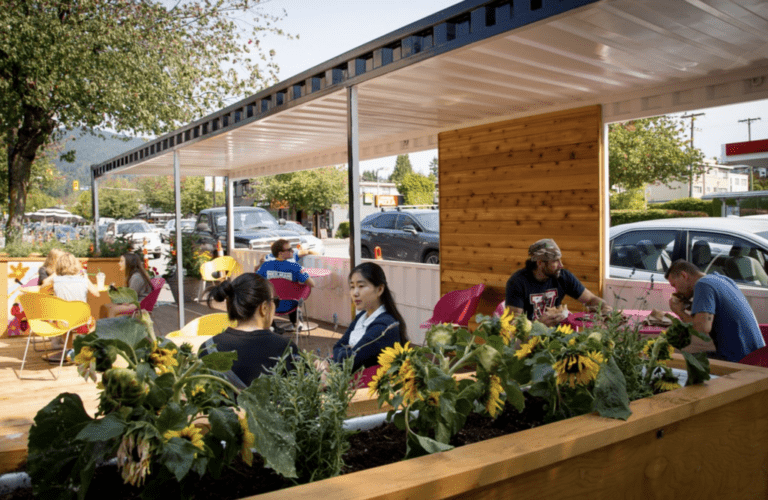On June 4, 2024, the Healthy Communities Initiative hosted a virtual Mobilizer Session, “Bouncing Forward: Cultivating Connection, Belonging and Collective Resilience” with Anne Gloger of Catalysts’ Circle. The session explored the Connected Communities Approach, a model born out of the pioneering work at the East Scarborough Storefront and brought together a panel of HCI-funded initiatives to share their stories, reflections and learnings on what it takes to co-create across varied and diverse communities and contexts.
This article was written by Anne Gloger following the Mobilizer session to further explore the principles and practices that can unlock the potential of connected communities.
Bouncing Forward
By: Anne Gloger
Have you noticed how when we tell stories or try to recall events, COVID-19 has become a reference point? Was that pre-COVID? we ask. What are you doing now, post-COVID? We do this because crises are defining moments for us as individuals, for our communities, and for our society as a whole. While COVID-19 is an example that we all share, individual communities across the country and around the world have experienced defining and traumatic events in their own contexts that forever change them.
I described one such event in a Mobilizer Session hosted by the Healthy Communities Initiative. I told the story of a traumatic event in 2012 when there was a mass shooting in an East Scarborough community that left people reeling: 22 young people were shot and two were killed. The story of the shooting itself and the grief and trauma that it caused families and friends of the victims is their story to tell, not mine. The story that I am able to share is about how community organizations, institutions, city staff, and grassroots groups came together to support this traumatized community. It’s a story about how these groups responded in the immediate shock of the event, yes, but more than that, it is about how they continued to meet over time to design and implement a whole community approach.
They put aside their organizational self-interest to support the community, not in bouncing back to how things were before this crisis, but to bounce forward to a new reality.
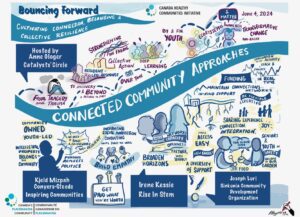
Visual graphic representing the virtual Mobilizer session. By Patricia Kambitsch/ Playthink.
Coming together: a community response
My colleagues and I were in the daunting position of convening, coordinating and aligning ideas, mandates and protocols so that we had a whole community response that was meaningful to local people. The day after the shooting, as I walked into that room where 70 passionate people, all wanting to help, were gathered, I felt a bit sick. How on earth were we going to quickly and effectively come up with the kind of collective, coordinated and relevant action plan we needed? As it turns out, we already knew how to do it: we had been putting the building blocks in place for more than a decade; how we used those building blocks is what I will describe for you in this blog.
The first thing we did in the early days after the crisis was to convene all the key players and to seek clarity about our collective purpose from those closest to the ground. Those at the grassroots provided the direction:
- what to do: prioritize support for resident-led actions and
- what not to do: flood the community with well-meaning strangers
The fact that we had the capacity to take the lead from people at the grassroots didn’t just happen: it was a continuation of a way of working that we had collectively honed over the years. Supporting grassroots work and designing resident-centred strategies and joint action plans sounds straightforward. It sounds like how every community should work and yet, it was–and is like–swimming upstream in a system that is just not designed for it.
In East Scarborough, we were fortunate. Dozens of those very people who were in the room that horrible day, had had, more than a decade before, a once-in-a-lifetime opportunity: to collectively and collaboratively design a community organization from the ground up. What they designed was an organization that was purpose built to support just the kind of cross-sector community-centred approach that was needed on that day. The organization was the East Scarborough Storefront, and the approach, later named the Connected Community Approach, was about intentional network weaving, trust building and co-creation.
East Scarborough youth breaking down barriers (removing a fence that blocked access to sports court and garden) Photo: East Scarborough Storefront
The Storefront had convened and facilitated these kinds of cross-sector, community-centred processes to co-create everything from markets and gardens to advocacy campaigns and even in the reclaiming and re-purposing of an old police station which was turned into a thriving community hub. Each of these community-building activities had helped us create the building blocks we needed now. They taught us that, before anything else, we needed to convene the right people, those at the grassroots and those with formal mandates and structures, to co-design a strategy that took the lead from those closest to the realities on the ground.
Weaving the social fabric
These building blocks are what we now call the community’s social fabric. It is a way of working that focuses on the connections and interactions that bind us all together as individuals and a society: grounded in our shared humanity. As professionals weaving social fabric, our priorities in all things–whether in a gardening project, an advocacy campaign, or responding to a crisis– are:
- Fostering a sense of belonging and agency
- Building trust between people and organizations/ institutions
- Facilitating understanding across difference
- Helping each other unlearn racist/ colonial practices
- Providing seamless access to a wide range of services
- Breaking down barriers to opportunity
- Connecting people with opportunities to engage in civic processes
- Creating opportunities to nurture the environment
- Supporting processes that make research, funding and policies relevant in the community context
Designing an action plan
And so we designed an effective and meaningful action plan that included actions by grassroots groups, frontline workers, executive directors, local businesses, and city staff among others; an action plan that was deeply grounded in resident priorities and the shared humanity of everyone involved, examples of which can be found in the table below.
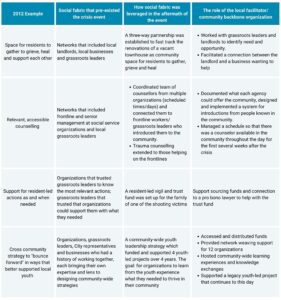
On that day and in the weeks and months that followed, I was so grateful to everyone for their good will, expertise and care. There were so many people who came back to the table day after day and then week after week to explore what a better future might look like. Convening and facilitating this group no longer felt daunting, it felt inspiring.
The fact that I worked at The Storefront meant that I could spend my time listening to stories, ideas, and worldviews and collaboratively explore ways of knitting them together into a cohesive and meaningful plan. When I tell people about our role as Storefront staff, they immediately recognize the value and are often surprised to learn that it isn’t a role found in every community. Clearly, we need people and organizations embedded in communities who can facilitate processes that break down silos, build bridges, explore ways to reverse the alarming trend of geographic marginalization, and bring people together to prepare for, respond to, recover from, and bounce forward after a major crisis event.
But this role, if it exists at all, is typically done off the side of someone’s desk, by someone who is either unpaid, or paid to deliver one specific program or service, not facilitate collective processes.
In Canadian society, we celebrate connectedness. In the wake of COVID-19 and the racial reckoning of 2020, there have been increased cries for “nothing about us without us” approaches. And every day our understanding increases about just how fragile the trust between people and organizations/institutions is. Strengthening a community’s social fabric is about what happens on the ground, but it can’t be downloaded onto the backs of unpaid or poorly paid people to take on the weight of issues that may play out in community, but stem from systems beyond their control.
We need systems-level players and community players working together.
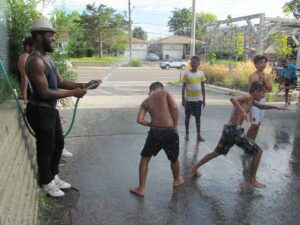
Youth using public space to address issues of heat in the community. Photo: East Scarborough Storefront
And yet, with a few notable exceptions, there is very little funding available for this kind of work and there is little focus on training people to do it.
One of those notable exceptions helped the East Scarborough community bounce forward in the wake of the 2012 tragedy. As people came to the table week after week, we began to see what was needed: an approach that helped us all learn from youth themselves what was needed and expected from the organizations and institutions designed to support them. And one funder got it.
The Youth Opportunity Fund recognized the value of a whole community approach to creating a new, better normal after a major crisis event. They funded a bouncing forward strategy that put youth at the forefront.
For the next four years, we were able to fund and support four youth-led groups to design and implement their own projects and the rest of us to focus on learning from their experience. 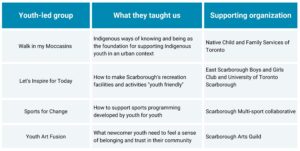
Everyone had a role to play: ours at The Storefront was to facilitate processes (logistical and strategic) so that learning was embedded across the community and linked to city-wide strategies like Toronto Strong Neighbourhood Strategy (City of Toronto) and Action for Neighbourhood Change (United Way). And for those four years we were funded to do just that. For most of my time with The Storefront, and to this day, however, Storefront staff have had to piece together funds in creative ways in order to be the organization that we were designed to be.
The Storefront was created by the community for the community in East Scarborough because that’s what was and is needed: a facilitator of collective processes. Over the years,The Storefront was able to take a step back and reflect on just what was different about their focus that had provided the building blocks for a whole community response to crises.
The reflection led to codifying the approach into a framework now known as the Connected Community Approach.
The Connected Communities Approach
The framework is practical and adaptable and can be activated at the local level or by institutions seeking to use their mandates to contribute to local communities. It offers a “how to” methodology framed around 10 keys to unlocking the potential of every community to prepare for, respond to, recover from, and bounce forward after a crisis.
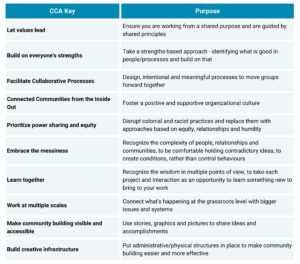
I tell the story of the 2012 shooting for three reasons. First, because supporting the response, recovery, and subsequent “bouncing forward” forever changed me–. It was a defining moment that galvanized my belief in people and my belief in community. It is in no small part because of the events of 2012 that I have chosen to dedicate myself to helping people, organizations, and institutions in uncovering their own capacities to contribute to the health, equity, and resilience of their communities.
Secondly, I tell this story because it is a compelling example of what can happen when we are intentional about investing in and building the capacity of communities. to nurture the underlying conditions that make it possible for people, organizations and institutions to address issues and challenges collectively and effectively.
Finally, I hope that this story may help inspire new ways of preparing for crisis events that go beyond emergency management to focus on the interactions and connections that bind us together as individuals and as a society.
______________________________________________________________________
To learn more about the Connected Communities Approach, watch the full Mobilizer Session Presentation here and follow the Catalysts’ Circle on their website.

